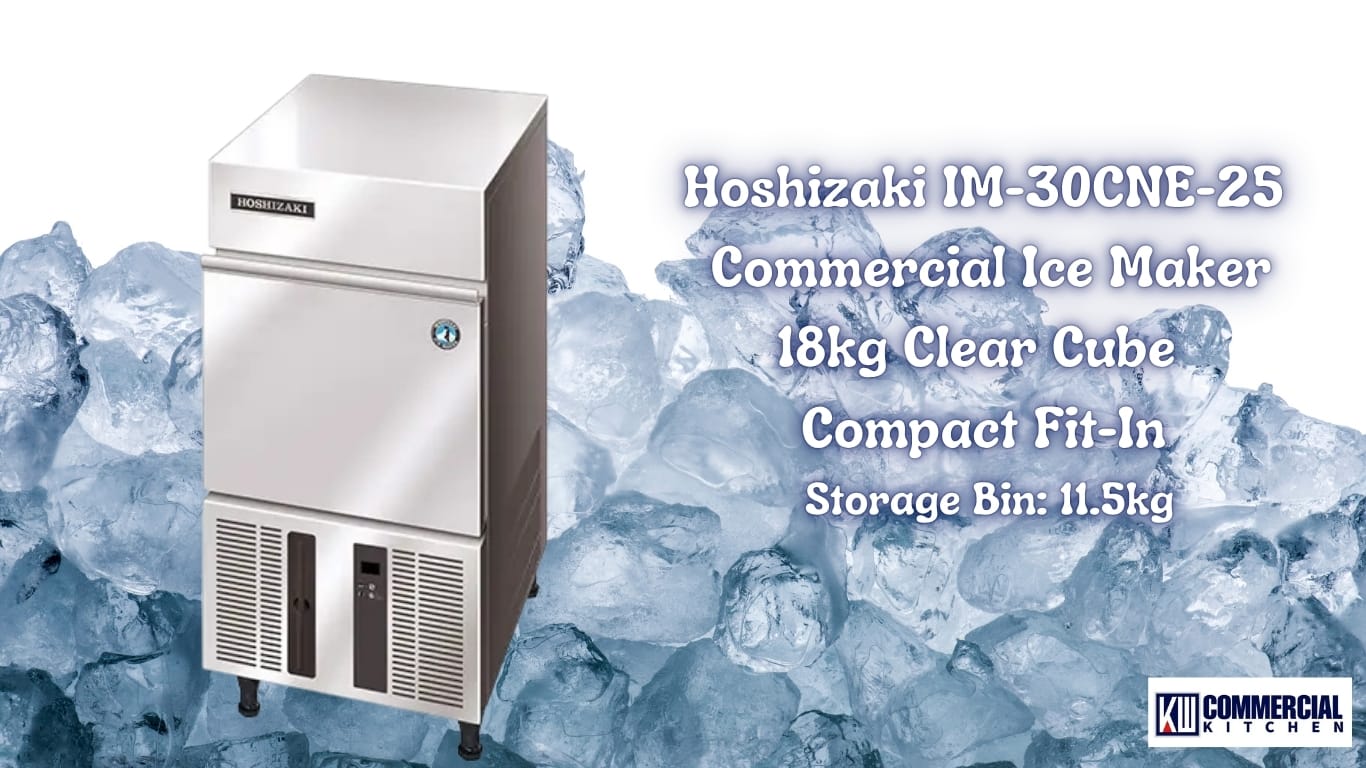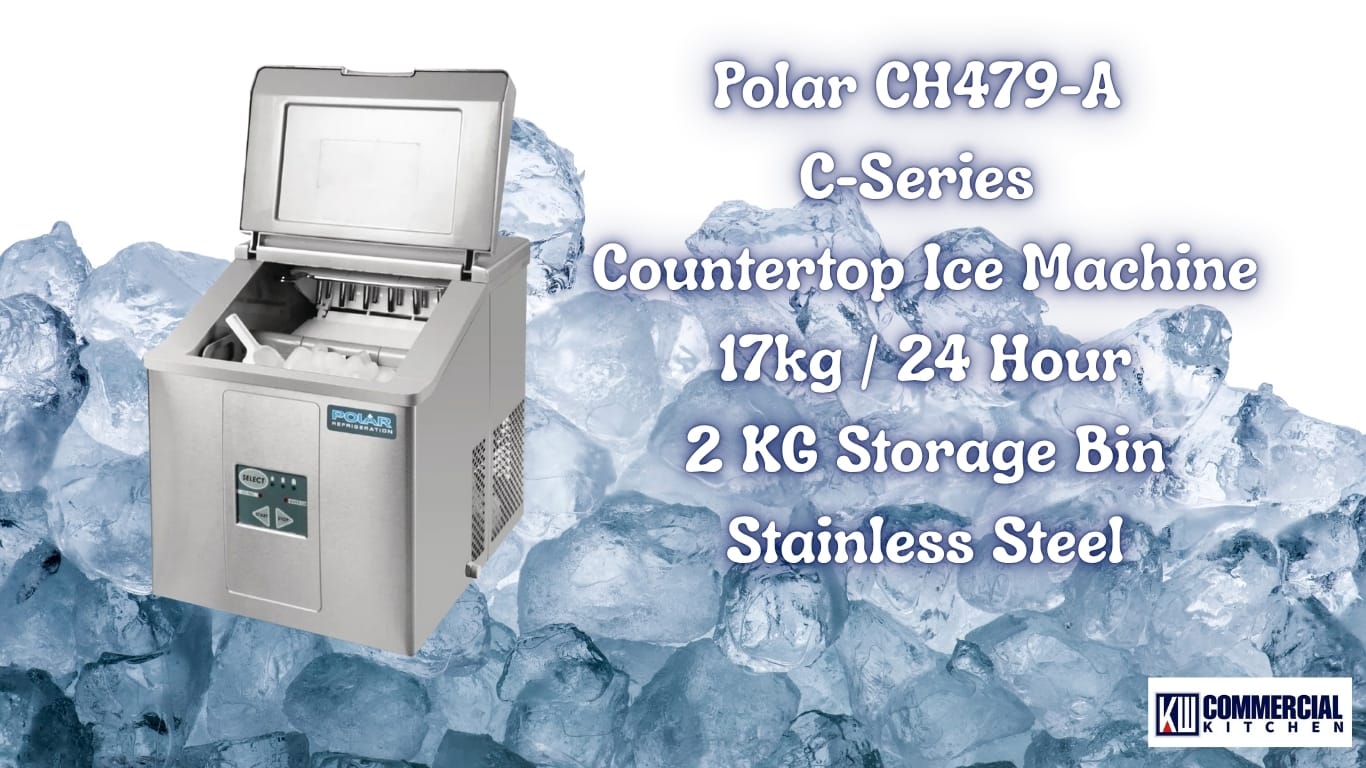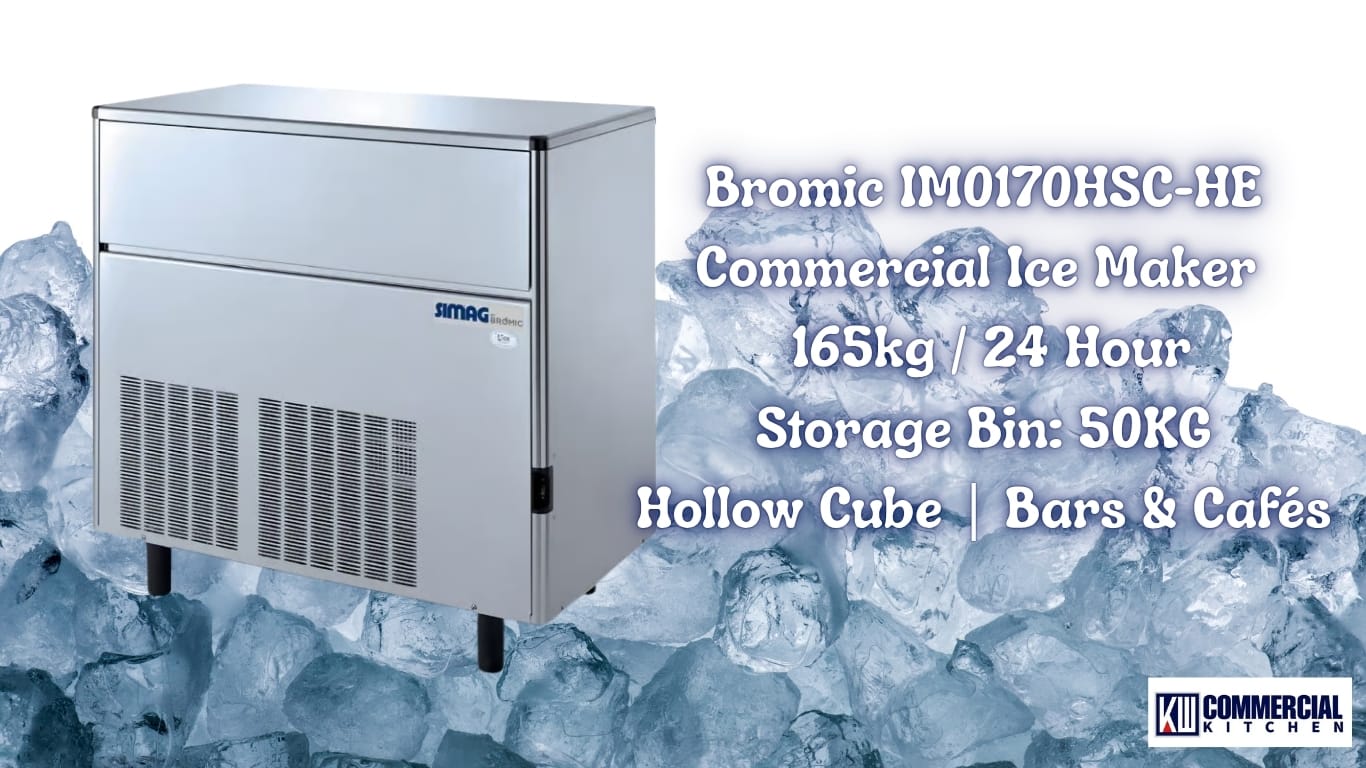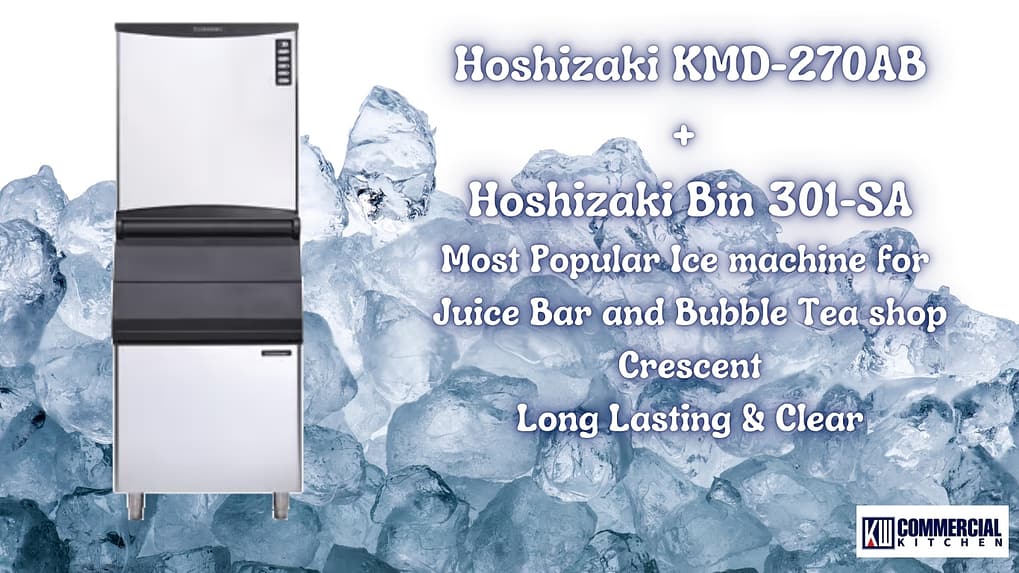Your Essential Guide to Selecting the Ideal Commercial Ice Machine for Australian Businesses
From trendy Melbourne cafés to bustling Sydney restaurants, commercial ice machines have rapidly become indispensable equipment across Australia’s hospitality industry. It’s no secret—Australians have a deep, year-round love for ice. Even in the heart of winter, locals famously ask for “a glass of ice-cold water” to refresh themselves. And as summer temperatures soar, demand for quality ice intensifies, making reliable ice production critical for hospitality businesses.
With this ever-growing demand, it’s more important than ever to understand exactly how much ice your venue requires. Different Australian establishments—from juice bars in sunny Queensland to busy pubs in Melbourne CBD—each have their unique ice needs. Whether it’s for cocktails, smoothies, seafood displays, or simply chilled beverages, the type and quantity of ice needed can vary significantly.
But choosing the perfect ice machine isn’t always straightforward. You need clarity on factors like daily ice production, ice cube types, transparency, water quality, and drainage requirements. Making the right choice ensures your business runs smoothly, avoids costly downtime, and delivers a consistently great customer experience.
In this detailed and easy-to-follow guide, we’ll walk you step-by-step through everything you need to know to choose the ideal commercial ice machine specifically tailored to your Australian business, covering:
- How to accurately estimate your daily ice requirements
- Comparing different ice types—cube, flake, gourmet and more
- The impact of ice transparency and hardness on your business
- Essential advice on water filtration and drainage solutions
- Top mistakes to avoid when selecting ice machines in Australia
- Recommended ice machine brands trusted by Australian hospitality professionals
Ready to make a confident, informed decision that suits your unique needs?
Browse our comprehensive range of premium commercial ice machines now: 👉 Commercial Ice Machines Australia
Understanding Your Ice Needs—Capacity Matters
Choosing the right commercial ice machine for your Australian business begins with clearly understanding your daily ice requirements. Selecting an ice machine with the appropriate capacity ensures efficient operation, minimises waste, and keeps your customers consistently satisfied.
Calculating Daily Ice Consumption in Australian Businesses
To accurately determine how much ice your business needs each day, follow this simple yet highly effective formula:
Ice Usage Formula:
(Number of customers per day) × (Average ice usage per customer) = Daily ice production required (kg)
Example: If your café in Sydney serves around 200 beverages daily, and each drink uses about 0.2 kg of ice, your calculation will be:
- 200 customers × 0.2 kg per customer = 40 kg/day
This quick calculation ensures you won’t underestimate or overestimate your daily ice needs.
Recommended Daily Ice Production for Different Australian Businesses
Based on extensive industry experience, here’s a practical guide tailored specifically for Australian hospitality and commercial settings:
| Business Type | Recommended Ice Production (kg/day) |
|---|---|
| Small Café (coffee-focused) | 20-40kg |
| Café with Juice/Smoothies | 30-80kg |
| Small Restaurant (no liquor licence) | 20-50kg |
| Restaurant with Liquor Licence | 40-70kg |
| Bar or Pub | 150-300kg |
| Bubble Tea & Drink Shops | 200-400kg |
| Events, Weddings & Parties | 50-80kg (per event) |
| Libraries & Council Facilities | 100-300kg |
| Schools | 50-80kg |
| Office Environments | 10-20kg |
This table provides an accurate and easy reference to determine the ideal ice production capacity, helping your business avoid costly mistakes and unnecessary stress.
For further assistance calculating your exact needs, utilise our specialised ice machine capacity calculator for Australia, ensuring your Sydney café or Melbourne restaurant always runs smoothly.
Understanding and meeting your daily ice requirements means happier customers, smoother operations, and consistent quality—essential components for long-term success.

Types of Ice—Which One Fits Your Business Best?
Selecting the correct type of ice for your Australian business directly impacts drink quality, customer satisfaction, and operational efficiency. Each ice type has distinct characteristics suited to specific scenarios. Here’s an accurate, detailed breakdown to guide your decision clearly.
Ice Cubes (Full & Half Cubes)
Best Suited for: Bars, restaurants serving cocktails, premium beverages, and cafés.
- Advantages: Exceptional clarity, attractive appearance, and very slow melting. Ideal for beverages where dilution must be minimal and presentation matters significantly.
- Disadvantages: Longer freezing cycles, higher energy usage, slightly slower ice production rate.
Bullet & Crescent (Half-Moon) Ice
Best Suited for: Juice bars, bubble tea shops, cafés, quick-service restaurants, and self-serve drink stations.
- Texture & Appearance: Highly transparent, dense, rounded shapes (bullet) or distinct half-moon shape (crescent), easy to handle and visually appealing.
- Advantages: Excellent thermal retention (slow melting), great for maintaining beverage quality over longer serving times. Offers consistent quality and clarity ideal for busy venues in Sydney and Melbourne.
- Disadvantages: Slightly slower ice production compared to flake ice. Bullet ice’s round shape may be less visually refined than full cube ice.
Flake & Granular Ice
Best Suited for: Seafood displays, fresh produce preservation, healthcare and medical applications.
- Texture & Practicality: Soft, granular texture similar to snow, easily mouldable and highly effective for rapid cooling.
- Hygiene Advantages: Ideal coverage and preservation properties keep seafood and produce fresh. Also widely used in medical and therapeutic settings due to rapid cooling capabilities.
- Disadvantages: Melts quickly due to high surface area; not suitable for beverage service or long-term cooling.
Specialty Ice (Gourmet Ice, Ice Balls, Ice Spears)
Best Suited for: Luxury bars, premium cocktail lounges, upscale restaurants, high-end hotels.
- Commercial Advantages: Premium clarity, impressive aesthetics, slow melting. Dramatically enhances beverage presentation and elevates customer experience, commanding higher drink prices.
- Disadvantages: Higher production costs, slower ice production rates, specialized equipment required.
Corrected Quick Comparison: Ice Types for Australian Businesses
| Ice Type | Transparency | Hardness | Melting Speed | Best for |
|---|---|---|---|---|
| Full Cube | High | Very High | Very Slow | Premium cocktails, spirits, upscale cafés |
| Bullet & Crescent Ice | High | High | Slow | Cafés, juice bars, bubble tea shops |
| Flake Ice | Low | Low | Fast | Seafood, fresh produce, medical use |
| Gourmet Ice (Ice Balls, Spears) | Very High | Very High | Very Slow | Luxury bars, fine dining, premium hospitality |
Choosing the right type of ice enhances your beverage quality, presentation, and customer satisfaction, whether you’re serving cocktails in sophisticated Melbourne venues or refreshing drinks at busy juice bars across Sydney.
For a more detailed analysis on choosing the perfect ice for bars and premium venues, see our comprehensive ice cube transparency guide for Melbourne businesses to ensure you’re delivering the ultimate customer experience.
Ice Quality—Hardness & Transparency Explained
The quality of ice you use directly affects your drinks’ appearance, taste, and the overall customer experience. Two critical quality factors every Australian hospitality business should consider are ice hardness and transparency. Let’s delve deeper to understand their importance and how to achieve perfect results.
How Ice Hardness Impacts Your Business
Ice hardness refers to the density and structural integrity of the ice cubes produced by your machine. Harder ice cubes offer significant advantages for businesses across Australia, especially in cities like Sydney and Melbourne, where competition is fierce:
- Slower Melting Rate: Hard ice cubes melt slowly, significantly reducing dilution of drinks. This ensures beverages maintain their ideal taste and strength, enhancing customer satisfaction.
- Improved Texture: Hard ice is ideal for premium drinks, cocktails, and high-quality spirits, ensuring a superior drinking experience and creating lasting customer impressions.
Ensuring Optimal Ice Hardness:
- Choose commercial ice machines known for producing high-density cubes.
- Use quality water filtration systems to reduce impurities, minerals, and air bubbles, resulting in denser ice.
- Regular maintenance and correct temperature settings significantly influence ice hardness.
Understanding the importance of ice cube hardness helps your Sydney or Melbourne business consistently deliver exceptional beverages, ensuring repeat customers and positive reviews.
Transparency—Why Clear Ice Matters
Ice transparency dramatically influences how your customers perceive beverage quality. Crystal-clear ice not only enhances drink aesthetics but also signals quality and professionalism to your patrons. But why can’t standard home ice makers produce crystal-clear ice?
Common Causes of Cloudy Ice in Home Machines:
- Water Quality: Unfiltered tap water contains minerals and impurities, creating cloudiness.
- Air Bubbles: Household ice machines typically freeze water rapidly, trapping air bubbles and impurities, causing opacity.
- Machine Power & Freezing Speed: Home machines lack the power and control over freezing speed found in commercial ice makers, leading to inferior clarity.
Commercial-grade clear ice machines designed specifically for Australian businesses employ slow-freezing technology that removes air bubbles and impurities gradually, resulting in crystal-clear cubes ideal for cocktails and premium beverages.
How to Achieve Optimal Ice Transparency:
- Invest in high-quality, clear ice machines explicitly built for commercial hospitality use in Australia.
- Install effective commercial water filtration systems to reduce mineral content and impurities.
- Regularly maintain and clean your ice-making equipment to prevent buildup of mineral deposits and impurities.
Taking these steps ensures your ice meets the highest clarity standards, enhancing beverage quality, impressing customers, and boosting your business reputation.
For further guidance on selecting high-quality, clear ice machines in Australia, check our detailed clear ice machines Australia guide to help your Sydney or Melbourne business stand out in the crowded hospitality scene.

The Importance of Water Filters in Australian Ice Machines
Water quality across Australian cities varies greatly, directly impacting ice machine performance, ice clarity, taste, and overall equipment lifespan. For businesses in hospitality, especially in major cities like Sydney and Melbourne, installing high-quality water filters isn’t just beneficial—it’s essential.
Why Water Filters are Essential for Australian Ice Machines
Different cities in Australia have distinct water qualities, affecting both ice quality and ice machine longevity. According to the official Australian Drinking Water Guidelines (Australian Government Department of Health), regional variations are notable:
- Sydney: Water has moderate hardness, meaning higher mineral content. Without filtration, mineral deposits such as calcium and magnesium quickly accumulate in ice machines, forming limescale, significantly reducing equipment lifespan and efficiency.
- Melbourne: Known for softer water with fewer minerals; however, chlorine and sediment levels still require filtering to ensure premium ice quality.
- Brisbane: Similar to Sydney, Brisbane experiences moderate water hardness, making scale build-up a major concern without proper filtration.
Economic Benefits & Equipment Longevity: Using an appropriate water filter directly extends your commercial ice machine’s lifespan. Limescale build-up, common in moderately hard water areas, causes compressors and valves to overwork, leading to frequent breakdowns and higher repair costs. Regularly replacing filters and managing water quality proactively protects your investment, dramatically cutting maintenance costs and operational downtime.
Types of Water Filters Suitable for Ice Machines
Choosing the right water filter ensures optimal ice clarity and taste, significantly extending your equipment’s life. While several filter types are available, original manufacturer-approved filters specifically tailored to your machine’s requirements offer superior performance:
- Carbon Filters: Effective in removing chlorine, organic compounds, and unpleasant odours. Ideal for Melbourne’s softer water.
- Carbon Filters with Sediment Removal: Highly recommended for Sydney businesses. These dual-function filters capture both minerals and small particulates, reducing scale and maintaining water purity.
- Carbon + Scale Inhibitor Filters: Essential for Brisbane establishments, these filters prevent scale deposits, ensuring consistently high ice quality and reliable machine operation.
Filter Replacement Frequency & Cost Overview
Regular filter replacement ensures continuous protection. Here’s a practical reference tailored for Australian businesses:
| City | Water Quality | Recommended Filter Type | Replacement Frequency | Average Annual Cost (AUD) |
|---|---|---|---|---|
| Sydney | Moderate Hardness | Carbon + Sediment | Every 6 months | $200 – $400 |
| Melbourne | Soft to Moderate | Standard Carbon | Every 6-12 months | $150 – $300 |
| Brisbane | Moderate Hardness | Carbon + Scale Inhibitor | Every 6 months | $200 – $400 |
Investing in the right filter significantly reduces unexpected breakdowns, improves ice quality, and ensures a higher return on investment. It’s not just a recommended step—it’s a critical business decision for Sydney, Melbourne, and Brisbane hospitality owners.
For a more detailed guide on selecting and maintaining filters, explore our specialised ice machine filter guide for Australia, designed specifically for businesses in Sydney, Melbourne, and across the nation.
Water Pump vs Drain Pump—What’s the Difference?
In Australia, choosing the correct drainage solution for your commercial ice machine is crucial. Many business owners mistakenly think water pumps and drain pumps serve identical functions, but they operate very differently. Let’s clearly define their roles and help you decide exactly what your business needs.
Understanding Drainage Requirements (Australian Regulations & Commercial Needs)
According to Australian plumbing regulations (AS/NZS 3500), commercial ice machines must drain excess water safely and hygienically to prevent health risks and maintain equipment performance. Generally, there are two drainage setups in commercial venues:
- Gravity Drain: A straightforward and cost-effective method using natural gravity. Requires the ice machine to be installed higher than a floor-level drain.
- Drain Pump: An electric pump system used when gravity alone isn’t feasible, such as when drainage pipes are above floor level or far from the machine.
Here’s a quick overview of typical Australian commercial ice machine installations:
- Restaurants & cafés: Often have floor drains, making gravity drains simple and practical.
- Basements, bars, and older buildings: Usually lack suitable floor-level drains, requiring the installation of drain pumps to manage wastewater.
When Do You Need a Drain Pump?
A drain pump is essential when your drainage outlet is higher than the ice machine drain or located some distance away. Without a drain pump, water accumulation can quickly lead to equipment damage, mould growth, and regulatory violations. Here are practical examples from Australian venues:
- Melbourne CBD Basement Bars: Often positioned below street level, gravity drains are impossible, making drain pumps mandatory.
- Sydney Waterfront Restaurants: Due to unique building layouts, ice machines may need drain pumps for efficient water removal, protecting valuable equipment.
Drainage Methods: A Quick Comparison for Australian Businesses
| Drainage Method | Advantages | Recommended For |
|---|---|---|
| Gravity Drain | Simple installation, cost-effective, reliable with minimal maintenance | Standard kitchens and venues with available floor drains |
| Drain Pump | Flexible installation, reliable water removal regardless of drainage height or distance | Basements, bar areas, older buildings lacking suitable drainage |
Ensuring correct drainage solutions protects your investment and helps your business meet strict Australian hygiene regulations. For additional assistance, explore our comprehensive ice machine drain pump guide Australia—perfectly tailored to businesses across Melbourne, Sydney, and beyond.

Top Commercial Ice Machine Brands & Models in Australia
Selecting the right ice machine brand and model can dramatically enhance your operational efficiency and customer satisfaction. Based on real Australian business feedback and market analysis, we’ve handpicked some of the best commercial ice machines, ideal for a variety of hospitality scenarios in Sydney, Melbourne, and across Australia.
| Brand/Model | Ice Type | Capacity (kg/day) | Price Range (AUD) | Ideal For |
|---|---|---|---|---|
| Scotsman ACM 47 AS | Gourmet | 24kg | $2,100+ | Boutique cafés, cocktail bars, upscale venues |
| Hoshizaki IM-130NE-28 | Cube Ice | 104kg | $5,736+ | Restaurants, high-volume hospitality businesses |
| Blizzard SN-700P | Cube Ice | 310kg | $5,510+ | Large restaurants, busy event venues, high-capacity needs |
| Polar GK031-A | Bullet Ice | 20kg | $1,350+ | Small cafés, takeaway outlets, quick-service restaurants |
Each model above is carefully selected based on Australian business reviews and proven performance across Sydney, Melbourne, Brisbane, and other major cities. Whether you’re managing a trendy boutique café or a bustling city restaurant, choosing the right commercial ice machine helps streamline operations, improves customer experience, and delivers a solid return on your investment.
Need further guidance or personalised advice? Explore our complete range of commercial ice machines and let our experts guide you towards the perfect solution tailored specifically for your Australian business.
FAQs—Your Top Questions About Ice Machines Answered Clearly
Commercial ice machines are vital assets for Australian hospitality businesses, yet questions often arise about maintenance, filters, troubleshooting, and operational costs. Here, we clearly answer the most common questions based on real scenarios from Sydney, Melbourne, and other Australian cities.
How Often Should I Maintain My Commercial Ice Machine?
For optimal performance, efficiency, and hygiene, Australian standards recommend professional servicing every 6 months. Regular cleaning and basic checks should be performed monthly. Neglecting scheduled maintenance can significantly reduce your ice machine’s lifespan and reliability.
How Can I Tell if My Ice Machine Needs a Filter Replacement?
Clear indicators your filter requires replacement include:
- Reduced ice production rate or smaller cubes.
- Cloudy or discoloured ice indicating poor water quality.
- Unpleasant odours or taste in ice.
Typically, filters in Sydney and Brisbane require replacement every 6 months, whereas Melbourne filters may last 6-12 months depending on usage and local water quality.
Common Reasons Why Ice Machines Stop Making Ice & How to Fix Them
When your ice machine stops making ice, common issues include:
- Blocked water filters: Replace or clean your filters regularly.
- Incorrect temperature settings: Ensure proper settings for your model.
- Water inlet issues: Check supply lines for blockages or leaks.
- Dirty evaporator plates: Routine cleaning solves many ice-production problems.
If issues persist, schedule professional servicing promptly to avoid extended downtime.
Daily Running Costs of Commercial Ice Machines—A Realistic Analysis (Electricity & Water)
Understanding real operating costs is essential for budgeting. Here’s a realistic daily cost breakdown using average electricity ($0.30/kWh) and water ($3.00 per 1,000L) prices in Sydney:
| Model | Production (kg/day) | Power Consumption (kWh/day) | Water Usage (L/day) | Daily Cost (AUD) | Monthly Cost (AUD) |
|---|---|---|---|---|---|
| Scotsman ACM 47 AS | 24kg | 8.0 kWh | 100L | $2.70 (Electricity) + $0.30 (Water) = $3.00 | $90 |
| Hoshizaki IM-130NE-28 | 104kg | 22.5 kWh | 250L | $6.75 (Electricity) + $0.75 (Water) = $7.50 | $225 |
| Blizzard SN-700P | 310kg | 35.0 kWh | 500L | $10.50 (Electricity) + $1.50 (Water) = $12.00 | $360 |
With clear operating cost insights, Australian businesses can easily calculate savings and profitability. Efficient ice machines reduce monthly expenses and improve bottom-line results. For example, selecting energy-efficient machines or using proper water filters to maintain efficiency can save hundreds of dollars annually—money directly boosting your profits.
For detailed advice and tailored recommendations, explore our comprehensive ice machine buying and maintenance guides specifically designed for Australian businesses, ensuring you achieve maximum efficiency and profitability.
Why Are My Ice Cubes Different Sizes?
Uneven ice cube sizes typically indicate issues related to water supply or the ice-making cycle. Common causes and quick fixes include:
- Inconsistent Water Flow: Check for blocked or partially closed water inlet valves. Ensure consistent water pressure and clean filters regularly.
- Uneven Temperature Settings: Incorrect evaporator temperature or thermostat issues can cause uneven freezing. Regularly calibrate your ice machine according to manufacturer guidelines.
- Dirty or Damaged Evaporator Plates: Routine maintenance and cleaning prevent build-up affecting uniform freezing.
Why Is My Ice Machine Leaking or Filling with Excessive Water?
Excessive water inside your ice machine often occurs due to drainage or internal component issues. Common reasons include:
- Blocked or Poor Drainage: Ensure drain pipes and lines are clear of blockages. Regularly inspect and clean the drainage system.
- Faulty Water Inlet Valve: A malfunctioning inlet valve may remain open, flooding the ice bin. Replace promptly if damaged or malfunctioning.
- Drain Pump Failure: If using a drain pump, verify it’s operating correctly and clear from obstructions.
If problems persist, promptly schedule a professional inspection to prevent equipment damage and ensure compliance with Australian hygiene regulations.
Conclusion—Invest in the Right Ice Machine for Long-Term Success
Choosing the ideal commercial ice machine for your Australian business goes beyond simply purchasing equipment—it’s a strategic investment directly influencing operational efficiency, customer satisfaction, and long-term profitability. Before making your final decision, remember these essential factors:
- Daily Ice Capacity: Accurately calculate your daily ice needs to ensure consistent service without overspending on capacity.
- Ice Type & Usage: Select the appropriate ice type—cube, bullet, flake, or specialty—based on your specific business requirements in Sydney, Melbourne, Brisbane, or other Australian cities.
- Ice Quality: Prioritise ice hardness and transparency to enhance drink quality, customer satisfaction, and your establishment’s reputation.
- Water Quality & Filtration: Invest in effective water filtration systems suitable for your local water conditions to extend machine lifespan and maintain premium ice quality.
A carefully chosen ice machine significantly boosts operational efficiency, reduces ongoing costs, and directly contributes to your bottom line. Make a smart, informed decision today for lasting success in the competitive Australian hospitality industry.
Ready to invest in the perfect commercial ice machine? Explore our comprehensive range or contact our expert team today for tailored recommendations and professional support.

